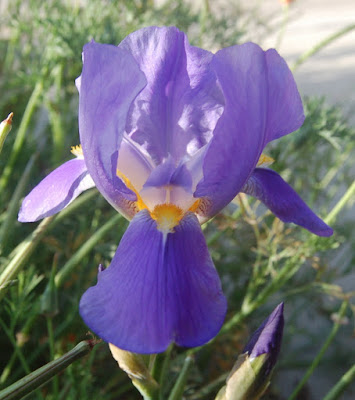By Andi Rivarola
Being a lover of Spuria irises, I finally picked up the booklet
The Eric Nies Chronicle, published by the American Iris Society, compiled and written by Mr. Nies’ granddaughter, Nancy Nies.
What a wonderful collection of stories and life experiences about someone so recognizable, but yet very much unknown to iris lovers of my generation. Reading it gave me a sense of loss in a way, for the great man, and for the inability to say, “Mr. Nies, I have a question for you about those Spurias you created.” How many other early manipulators of iris genes (artists, really) were out there, whose dedicated lives are lost, except in the memory of early American gardeners (few of whom) are still with us?
One of the most surprising pieces of information about Eric Nies is that he lived and created his irises right here in my town, Los Angeles. Secondly, what came to mind while reading this Chronicle is, why is it that Spurias have not taken off in popularity given the amount of work and dedication from early hybridizers? I don’t really know.
Eric Nies was born in 1884 at Saugatuck, Michigan, and was one of thirteen children. His parents were immigrants from Holland. In 1913 he moves with his family to Los Angeles. He starts his hybridizing work in 1920 (what about this year, that so many important events start surfacing in the world). As a supervisor of an elementary school’s agricultural center in Los Angeles, Mr. Nies first comes into contact with Spuria irises.
“During his life time, my grandfather,” says Nancy Nies,
“received numerous awards and honors for his iris, on both the local and national levels. These included eleven Honorable Mentions and four Awards of Merit from the American Iris Society. One of the latter, presented to ‘Bronzspur,’ had the distinction of being the first AIS Award of Merit ever given to a Spuria; another, awarded to ‘Orchid Sprite,’ was the first AIS Award of Merit ever won by a Pacific Coast native iris.”
The chronology presented by Nancy Nies says that in 1933 Eric Nies joined the AIS, helps establish the Southern California Iris Society (still functioning today), and the Annual Hollywood Iris Show. Imagine that, an iris show around the glamour and seduction of those Hollywood days. Because he lived in the heart of Hollywood, entertainment stars were part of his iris-fan base and more so, after he named at least one of his bearded irises after one of them. The Hollywood Citizen News for April 21, 1944 reads, “Iris Named For Actress.”
I was also happy to read that as late as 2002 the Nies/Walker Spuria cultivar, ‘Driftwood’ received the Royal Horticultural Society’s Award of Garden Merit.
Ironically, the American Iris Society awarded the Hybridizer’s Medal to Eric Nies in 1952. He never knew he had received it though since he died in January of the same year.
Marion Walker, who took over some of Eric Nies’ work after his passing, said in the 1952 Bulletin, “His interest in botany led to his becoming an outstanding landscape architect. He had an exceptional love of beautiful flowers and plants, especially the delicately textured ones such as the bearded iris.”
From the Bulletin of the American Iris Society #141 (April 1656) 36-39:
“Although the catalogues of one of the pioneer commercial growers in Southern California, Mrs. Jennett Dean of the Moneta Gardens, offered Spuria hybrids for use in perennial borders, it was not until a chance break caught the attention of Eric Nies in the late 1930s and started him on a serious breeding program, that interest in this member of the iris family was revived. The species ochroleuca had been planted generously in home gardens and estates for its foliage accent and wealth of bloom in season, but the use of the newer hybrids has been a slow but steady climb into popularity. At present time Spurias are being used in planted coves along the freeways leading to the heart of Los Angeles, and in greater number in the parks and in private gardens. Interest in them has spurred the members of the Southern California Iris Society to grow all the available species in that section… The standard of perfection as set by Eric Nies for himself and now followed by others has improved the offerings.”
Eric Nies goal was to develop,
“a well-formed, reasonably tall blue Spuria,” that he could use as a landscape architect, but that didn’t deter him from producing and introducing was seems to be the first brown Spuria, ‘Bronzspur.’
Marion Walker wrote as part of a published obituary,
“He was looking forward to 1956, when the AIS [National Convention] is scheduled for Los Angeles, with the keenest anticipation, and had been exhorting the local growers to place more emphasis in their plantings on the native varieties for that event.”
Hope these few glimpses of this pioneer of our iris world will inspire you to read more about him or earlier iris hybridizers. Information about The Eric Nies Chronicle may be found through the
Spuria Iris Society. Other Historic Chronicles may be obtained from the
Historic Iris Preservation Society.
Note 1: I could not find original pictures of Eric Nies introductions. If you have any, would share them with us? Thank you.
Note 2: For AIS history buffs: The only time an AIS National Convention was held in Los Angeles, was in 1956.





